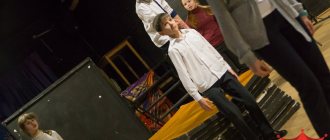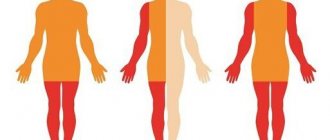04.01.18
Why do children with autism resort to stereotypic behavior (stimming) to self-soothe, and how to help them avoid harmful stereotypies
Author: Karen Wang / Karen Wang Source: Friendship Circle
Each of us has motor stereotypies. When I talk to my friend, I twirl my hair on my finger. Maybe you start biting your nails when you're nervous or bored. Maybe you have a habit of tapping your fingers or pen on the table when you are thinking. I had a friend who liked to chew cinnamon sticks, and I know someone who makes unusual eye movements.
There are people whom I recognize from afar by their characteristic movements. We all know people with annoying stereotypes, such as cracking their knuckles every 5 minutes, repeating the same phrase over and over again, or socially unacceptable stereotypes such as picking their nose or biting their hand.
What is stereotypy
Stereotyping is any purposeless, repetitive movement, sound or word. In autism they are present in the vast majority of cases. My son's neurologist calls them "autistic stereopathies." They are also called “self-stimulation” or, in colloquial language, “stimming”.
The Diagnostic and Statistical Manual of Mental Disorders, Fifth Edition, includes stereotypy as one of the diagnostic criteria for autism spectrum disorder: “Stereotypical or repetitive motor movements, use of objects, or speech.” The guidelines also state that the diagnostic criteria are: “Symptoms that cause clinically significant difficulties in social functioning, employment, and other important areas of current functioning.”
This is the difference between autistic stereotypies and ordinary stereotypies. It is a symptom of autism only when stereotypies interfere with everyday tasks and learning.
Establishing diagnosis
Diagnosis of speech stereotypies involves comprehensive testing. The patient is asked to undergo special testing or answer simple questions (implying “yes” or “no” answers), repeat similar-sounding sounds or sound combinations.
The patient is also asked to name the objects that are in the room, name the days of the week, explain the meaning of the words, and retell the text.
When examining a patient, it is very important to determine whether he understands speech addressed to him. If there is a suspicion of mild forms of speech disorders, the speech pathologist uses other more complex diagnostic methods.
To diagnose speech stereotypies, a technique is used that includes a series of separate tests. The patient is asked to write words in normal and reverse order, write words and phrases in upper and lower case letters, read text in forward and reverse order, write numbers in normal and reverse order, and perform multiplication. When making toasts, the doctor assesses the number of correct and incorrect answers per minute.
Wrong question
“How to stop stereotyping?” This is usually the first question parents ask when a young child discovers stimming. And this is the wrong question.
First, all people have self-stimulating behavior, so it is basically impossible to completely stop it. Secondly, even if you get rid of one stereotype, another will replace it - and there is a risk that the next stereotype will be much more problematic.
And most importantly, your attempts to stop stereotyping may make your child want to avoid you and communication with you, as a result, you will lose opportunities for social interaction.
Therapy and correction
Treatment of patients with speech stereotypies involves the following techniques:
- pharmacotherapy;
- physiotherapy;
- psychotherapy;
- psychological correction;
- physiotherapy;
- logotherapy;
- working with defectologists.
It is necessary to begin therapy with treatment of the main provoking disease. The ability to restore speech function will depend on the main diagnosis.
If the patient has aphasia, the main emphasis is on automated speech, then the patient is gradually taught to comprehend and separate the main from the secondary. If the underlying disease is dementia, during therapy they focus on the semantic meaning of words. Patients with a mild form of schizophrenia are taught to correctly construct sentences that preserve semantic content.
In Western countries, when treating these disorders, the main emphasis is on drug therapy. Neuroleptics are the most widely used. They contribute to changes in the pathological processes of the brain.
Valid question
“Why is my child engaging in this behavior?” It is always better to start by looking for the cause and understanding the motivation behind the behavior. Here are some possible reasons and hypotheses to explain stereotypies:
Overstimulation: Stereotypes help block out unnecessary sensory information from the outside world and avoid overload.
Insufficient stimulation: Stereotypes can provide additional sensory stimulation when needed.
Reduce Pain: Repeatedly hitting the head or body can reduce the overall feeling of pain. It is hypothesized that stereotypies release beta-endorphins, which act as an anesthetic or induce pleasure.
Managing Emotions: Both negative and positive emotions can cause a “surge” of stereotypies. We've all seen reactions to joy or delight such as jumping or shaking our hands. Dissatisfaction or anger can increase stereotypies to the point where they become dangerous.
Self-regulation: Some stereotypies are a way to self-comfort or calm down. So many babies suck their fingers to relax.
Not long ago I read on one mother’s blog that she did not understand why her son covered his ears with his hands in his sleep. He began to cover his ears when things were too noisy, and this calmed him down. So he started covering his ears whenever he needed to calm down, including when he fell asleep.
About the developmental features of a healthy child with skin vector
The skin vector provides a healthy baby with amazing mobility and dexterity, and good motor skills. From birth, these babies have especially sensitive skin, receptive to the slightest touch. Physical punishment represents unbearable suffering for a skinned child; they should never be beaten.
Children with the skin vector have an engineering mindset. From early childhood, they enthusiastically build something, be it the first tower made of cubes or a complex spaceship from all the furniture that comes to hand in the house. They have excellent rational thinking, based on an innate sense of benefit and benefit. They master counting skills earlier than other children. In the future, this will help a child with the skin vector become an excellent engineer, businessman, and even a worker in the field of law.
How to reduce stereotypies
Here are some ideas on how you can reduce your time spent on stereotyping while developing your communication skills:
- Medical examination to rule out physical causes of stereotypies, for example, ear infections, chronic pain, migraines, retinal detachment.
— Improving the sensory and emotional environment so that the child is more comfortable and the need for self-comfort is reduced.
— Sports, exercise and other intense physical activity reduce stereotypies. This may be due to the fact that exercise releases beta-endorphins, as does stereotypy.
— Continue communication, even if stereotypes arise. James MacDonald suggests that people with autism perceive the world around them more through sensations and actions, while neurotypicals perceive the world more through thoughts and language. If you understand this difference, then stereotypes become more meaningful. MacDonald recommends doing different activities in turn, without trying to stop the child’s stereotypies, just involving him in the activity is enough. Gradually, joint activities will become more familiar and attractive for the child, and this will naturally reduce stereotypy.
— Creating a positive association between stereotypy and social interaction. One way to use stereotypy for learning is to allow stereotypy as a reinforcer or reward after a short period of playing or working together. Julia Moore believes that if you set aside a scheduled time for stimming after communication, this will allow the child to be himself, motivate him to communicate more often, and at the same time, the total time he spends on stereotypies will decrease.
— Join the stereotype! Some approaches ask adults to engage in self-stimulating behavior to initiate communication. For example, if your child is spinning plates, start spinning the plates too. If your child is rocking, start rocking next to him too. My son would “stimulate” by raising his hand and talking to her as if he were looking in a mirror. He was delighted when I started doing this with him!
You can then add new things to your interaction, such as gestures so your child can ask for what he wants. The basic principle is to offer the child experiences that will produce similar sensations to stereotypy, but that are more functional and will promote greater self-regulation.
In other words, to reduce stereotypy, offer a replacement that is more attractive!
Stereotypes in children with autism spectrum disorder and autism
What is "stereotypy"? This term is often used when we talk about autism or autism spectrum disorder.
Stereotyping is any purposeless, repetitive movement, sound or word.
Each of us has stereotypes. For example, twirling your hair around your finger during a conversation, the habit of tapping your fingers on the table or biting your nails out of boredom or anxiety. Someone cracks their knuckles or bites their lips or fingers.
In autism they are present in the vast majority of cases. The Diagnostic and Statistical Manual of Mental Disorders, Fifth Edition, includes stereotypy as one of the diagnostic criteria for autism spectrum disorder: “Stereotypical or repetitive motor movements, use of objects, or speech.” The guidelines also state that the diagnostic criteria are: “Symptoms that cause clinically significant difficulties in social functioning, employment, and other important areas of current functioning.”
This is the difference between autistic stereotypies and ordinary stereotypies. It is a symptom of autism only when stereotypies interfere with everyday tasks and learning.
Often, stereotypies in children with ASD attract excessive attention from others, or cause discomfort to the child, and parents want to stop them. Is it necessary to do this?
First, all people have self-stimulating behavior, so it is basically impossible to completely stop it. Secondly, even if you get rid of one stereotype, another will come to replace it - and there is a risk that the next stereotype will be much more problematic.
And most importantly, attempts to stop stereotypies can cause stress in the child and reluctance to communicate.
It is important to understand why the child resorts to such behavior and to find the reasons for the appearance of stereotypies.
There are several possible reasons and hypotheses to explain stereotypy:
- Overstimulation: Stereotypies help block out unnecessary sensory information from the outside world and avoid overload.
- Insufficient stimulation: Stereotypies can provide additional sensory stimulation when needed.
- Reduce pain: Repeatedly hitting the head or body can reduce the overall feeling of pain. It is hypothesized that stereotypies release beta-endorphins, which act as an anesthetic or induce pleasure.
- Emotion management: Both negative and positive emotions can cause a “surge” of stereotypies. We've all seen reactions to joy or delight such as jumping or shaking our hands. Dissatisfaction or anger can increase stereotypies to the point where they become dangerous.
- Self-regulation: Some stereotypies are a way to self-comfort or calm down. So many babies suck their fingers to relax.
An example of the positive function of stereotypy: a child began to close his ears when the environment was too noisy, and this calmed him down. Subsequently, he began to cover his ears whenever he needed to calm down, including when he fell asleep.
When should stereotypies be reduced?
Stereotyping can interfere with learning, communication, and negatively impact social situations. Some types of stereotypies cause physical harm and may cause inflammation or require surgery.
Stereotypes may be the result of a medical problem, such as migraines in a person with a disability who cannot talk about their pain.
How to reduce stereotypies?
- You can diversify the child’s environment, his environment, “saturate” it, so that he has more opportunities to occupy himself with something.
- Distract the child, if you notice the appearance of stereotypies, switch his attention to something else.
- Hug more often, say nice words.
- Physical exercises, sports, outdoor games, trampolining reduce stereotypies.
People with autism perceive the world around them more through sensations and actions, while neurotypical people perceive the world more through thoughts and language. If you understand this difference, then stereotypes become more meaningful. There is no need to try to stop the child’s stereotypies; it is enough to simply involve him in the activity. Gradually, joint activities will become more familiar and attractive for the child, and this will naturally reduce stereotypy.
One way to use stereotypy for learning is to allow stereotypy as a reinforcer or reward after a short period of playing or working together. If you allocate scheduled time for stereotypy after communication, this will allow the child to be himself, motivate him to communicate more often, and at the same time, the total time he spends on stereotypy will decrease.
To improve communication with a child with autism spectrum disorder, join the stereotypy! For example, if your child is spinning plates, start spinning the plates too. If your child is rocking, start rocking next to him too. Then add something new to your interaction, such as gestures that your child can use to ask for what he wants. The basic principle is to offer the child experiences that will produce similar sensations to stereotypy, but that are more functional and will promote greater self-regulation.
Prepared material
Vesnina N.N. – department psychologist
psychological and pedagogical assistance
How to set up a study area and improve the learning process
It is especially important that the workplace for studying with a child is equipped correctly: the table should be located along the wall, on which there is no need to hang anything. Autistic children with the skin vector are already unable to concentrate for a long time, and if they are distracted by the view outside the window or a colorful poster on the wall, you simply will not achieve anything in the lesson.
A healthy child with a skin vector is very sensitive to issues of benefit and benefit, as well as to the use of his time. An autistic child is no exception. Motivation will also work well here: if you do this, you will get this. At first, you can offer a treat as a reward, and later - a trip to the park, on a swing, or to other places your child loves. If he does not perceive information well by ear, just show a photo of where you will go after class.
Time issues are a different story. Let's assume that you managed to motivate your child and he is ready to study in anticipation of a reward. But a skin-sound autistic person is extremely restless; it is basically unclear to him when this torment will end, and he begins to get nervous literally a couple of minutes later.
Visualizing time (for example, using an hourglass) can help here. Another way is to visualize the scope of upcoming tasks. Just use several boxes and number them. Put a task in each one. First, this slide lies, for example, on the right side of the table. As you complete, you transfer the waste material to the other side. This gives the child a visual representation of how much work remains to be done. Protests on this issue will become much smaller over time.
What to do
Children with the skin vector love to count. But in an autistic child this takes on the character of a “counting game” - a repeated stereotypical action. Therefore, learn as early as possible to correlate the real number of objects with the image of the figure. A practice such as setting the table together helps a lot. How many forks do you need? Take it, count it. Spoons, napkins, plates, etc. Later you can ask the question: “How much is missing?”
The skin vector also conveys to the child the desire to design. In autistic children, this results in building rows of all objects available to the child - cubes, cars, spoons, etc. During the lesson, encourage the child to build according to the pattern after you. A set of geometric shapes will be a great help, as an option - a magnetic set for use on a special board. Later the child will be able to master the application. Puzzles are also very good for children with skin and sound skills.
All kinds of games with unstructured materials - sand, water, plasticine - are also useful for skin children. They give the child a lot of tactile sensations that are so valuable to him. You can use your finger to draw on grains, sort beans by color, or work with fabrics of different textures.
If a child accepts finger paints, this is another option for extracting pleasant and at the same time useful sensations. When a child's hand is well developed, he will enjoy working with colored sand, from which he can create a multi-colored picture.
Later, fine motor skills need to be complicated: appliqué and origami, coloring and tracing objects along dotted lines and contours, completing elements of copybooks.
Diagnostics
The diagnostic program includes the following activities:
- visual examination of the child;
- clarification of the current clinical picture, collection of personal and family history;
- studying the patient's medical history.
In addition, additional laboratory and instrumental research methods may be required:
- general and biochemical blood test;
- CT, MRI of the brain;
- psychiatric tests.
Carrying out a computed tomography scan for a child
You may need to consult a neurologist, ophthalmologist, otolaryngologist, child psychologist, or speech therapist.
Special recommendations for daily routine
Autistic children with the cutaneous vector are often hyperactive and extremely restless. This disinhibition leads to excessive stimulation of the nervous system, especially towards the end of the day. Many parents of such children complain that they cannot establish a normal routine.
Meanwhile, this is the first thing to do in such a situation. Even a healthy child with a skin vector feels the need to have rules, a daily routine and actions, a system. Autistic people are no exception. But giving them rules and routines requires much more strength and consistency from parents.
All routine moments (feeding, walking, exercising, sleeping) should take place strictly at the same time every day. At first it may seem that you are building a barracks for your child with your own hands, but this is not at all the case. At first he may protest, but then he will obey the repeated rules and feel better within the given structure of time. Evening sleep will improve.
The system of prohibitions and restrictions must be observed by all family members without exception. If necessary, let compassionate grandmothers read this article. Get together and discuss once what the child is allowed and what is not, and in what cases options are possible.
Further, the system of rules and restrictions should work equally for dad, mom, and other family members. If a child is strictly forbidden to touch medications, then no one allows this. And it doesn’t matter that it’s not at all dangerous to rustle with empty packaging.
Taking into account the child’s field behavior, the space should also be structured into zones. Such a child should not eat and study in the same place. No matter how small the apartment is, try to divide it into zones: this is a corner for playing, this is a table for studying, and we eat only in the kitchen.
Progression of pathological symptoms after 1 year
In a healthy child with a skin vector, from the moment he masters walking skills, motor activity begins to rapidly increase. In an autistic child with a skin vector, the same thing happens: parents often note that such a child did not walk, but immediately ran. Moreover, as a rule, this happens even earlier than the average statistical norm - approximately 9-10 months. But, unfortunately, the characteristics of these motor skills in autism also take the form of pathological symptoms.
Hyperactivity and disinhibition occur. Yes, the child is running. But he runs without a goal, it seems as if the surrounding field of space is capturing and pulling him. He cannot concentrate his attention for a long time, his gaze “sliding” along objects and people. Experts call this set of symptoms “field behavior,” but only systemic knowledge helps to understand what this behavior is associated with.
The number of motor stereotypic movements is constantly growing: strange gestures appear, the child takes unusual poses, walks on tiptoes, strains certain parts of the body, twists his fingers. He can also circle around his axis, rhythmically bend and straighten his fingers, shake his fingers or hand, and jump in place. Sometimes there is a completely pretentious drawing of such stereotypes.
The desire to rock, which began in infancy (while sitting in a playpen or on a rocking horse for a long time), also develops into motor stereotypy, a constantly repeated thoughtless action. At the same time, sometimes one simply admires the extraordinary dexterity, grace and smoothness of movements when climbing and balancing. Nevertheless, attempts to use these qualities to teach a child voluntary movements fail.
Often, as a way of understanding the world around us, a skin-sound autistic child prefers to feel objects. That is why he experiences special pleasure from pouring cereals, the sensation of tearing and flaking fabrics or paper, pouring sand or pouring water. If in a healthy child with a skin vector such interests arise only in infancy and are quickly replaced by constructive activities, then in an autistic child such manifestations can persist for many years.
Symptoms
The clinical picture of this disorder will be characterized depending on the form of the course.
Thus, stereotypies in speech will manifest themselves in the form of the following symptoms:
- the child constantly repeats the same words or phrases (perseveration);
- what is spoken has no meaning;
- attacks are characterized by frequency, usually after severe stress or emotional shock.
Motor stereotypy is expressed in chaotic or similar movements: waving arms, walking in a circle, and so on. The frequency of attacks is the same as in the case described above.
The most pronounced clinical picture is characterized by dynamic stereotypy.
In this case, symptoms such as:
- the child performs the same type of actions in a circle - rearranging toys, pouring sand;
- makes the same movements for several minutes;
- behaves restlessly, may be hyperactive;
- pronounces the same words;
- may start crying or laughing for no reason.
The manifestation of such a symptom, if therapy is not started in a timely manner, leads to complete social maladjustment of the baby. In addition, it should be remembered that the general clinical picture will be supplemented by specific signs of the underlying factor, therefore dynamic stereotypy will be supplemented by signs of mental retardation and retardation in psychological development. Also, such children often have problems with hearing and vision.
If such a symptom is present, parents should immediately seek medical help. The doctor will conduct an examination, determine the root cause and prescribe a course of therapeutic measures.
Classification
This disorder is classified according to the nature of the clinical picture.
The following forms are distinguished:
- Motor stereotypies - the patient periodically makes the same movements. As a rule, attacks occur during psycho-emotional arousal.
- Speech stereotypies - the patient constantly repeats the same words or entire phrases. At the same time, they do not carry a semantic load.
- Sensory-motor - the baby can make the same type of movements - rubbing his eyes, twisting his hair, walking in a circle.
Separately, it should be said about this type of pathological process as dynamic stereotypy. In this case, the clinical picture may combine several forms of such a disorder. In addition, the child can perform the same type of actions every day. For example, going to school along the same route, keeping the door to the room always open, leaving one object strictly in its place, and so on.
In general, determining the form of the pathological process does not cause difficulties, since the clinical picture has specific signs.









